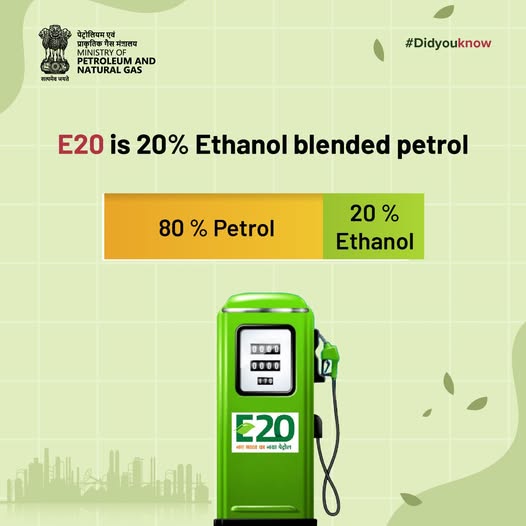Ethanol Blending in India

- 02 Sep 2025
In News:
India has been steadily advancing towards ethanol blending in petrol to reduce dependence on fossil fuels, cut carbon emissions, and boost the agricultural economy. Recently, debates have intensified after the nationwide rollout of E20 fuel (20% ethanol + 80% petrol) in July 2025—five years ahead of its initial 2030 target. Concerns were raised about its impact on older vehicles and consumer safety.
What is Ethanol Blending?
- Ethanol (C?H?OH): A renewable, biodegradable, and clean-burning fuel derived from biomass such as sugarcane molasses, rice, maize, barley, and wheat.
- Ethanol Blending: Mixing ethanol with petrol to increase oxygen content, leading to cleaner combustion, reduced greenhouse gas emissions, and lower crude oil imports.
- India’s Ethanol Blended Petrol (EBP) Programme began in 2003.
- Progress:
- 10% blending target achieved in 2021-22
- 12.06% in 2022-23
- 14.06% in 2023-24
- 20% blending achieved in July 2025, ahead of the 2030 deadline.
E20 Fuel and Automobile Industry Response
- E20 fuel is now being offered at petrol pumps, replacing earlier E5/E10 options.
- The Society of Indian Automobile Manufacturers (SIAM) confirmed that warranties will remain valid for older cars even if they were not originally designed for E20.
- Automakers are issuing dealer advisories on E20 usage in pre-2023 vehicles, when flex-fuel-compatible models began rolling out.
- The government has also announced guidelines for 27% ethanol blending, further deepening the transition.
Concerns and Challenges
- Fuel Efficiency & Engine Issues: Some vehicle owners have reported lower mileage and performance issues with E20.
- Warranty and Consumer Trust: Initial confusion over automaker responsibility raised fears of invalidated warranties.
- Agricultural Dependence: Heavy reliance on sugarcane and food crops raises concerns about the food vs. fuel debate and water stress.
- Supply Chain & Technology: Ethanol storage, transport, and blending infrastructure must scale up nationwide.
- Legal Challenge: A public interest litigation (PIL) on the impact of E20 is pending before the Supreme Court.
Benefits of Ethanol Blending
- Environmental: Cuts CO? emissions, improves urban air quality, and reduces vehicular pollution.
- Economic: Reduces crude oil imports (India imports ~85% of crude requirements), saving forex reserves.
- Agricultural: Provides a stable market for farmers through ethanol demand from crops like sugarcane, maize, and rice.
- Strategic: Contributes to India’s energy security and climate commitments under Paris Agreement & Net Zero 2070 goals.
Government Push and Future Roadmap
- Union Minister Nitin Gadkari has reiterated that higher ethanol blending is central to India’s green mobility transition.
- India is also exploring flex-fuel vehicles and second-generation (2G) ethanol derived from agricultural residues to address food security concerns.
- Targets:
- 27% blending roadmap under preparation.
- Expansion of ethanol production capacity through distilleries and 2G ethanol plants.
- Incentives for biofuel research, hybrid engines, and flex-fuel adoption.
